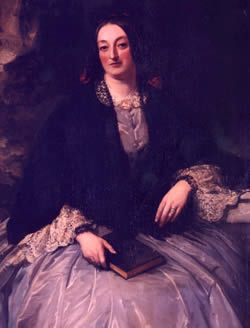Mary Rosse facts for kids
Quick facts for kids
Mary Parsons, Countess of Rosse
|
|
|---|---|
 |
|
| Born |
Mary Field
14 April 1813 |
| Died | 1885 (aged 72) |
| Spouse(s) | |
| Children | 11 |
Mary Parsons, Countess of Rosse (born Mary Field; 14 April 1813 – 1885) was an amazing Anglo-Irish woman. She was an amateur astronomer, an architect, and a furniture designer. She was also one of the first people to take photos using a special method with waxed paper. Many people just called her Mary Rosse.
Contents
Mary's Early Life
Mary Field was born on April 14, 1813, in Yorkshire, England. Her father, John Wilmer Field, was a very rich landowner. Mary and her sister, Delia, were taught at home by a governess named Susan Lawson. Susan encouraged Mary's creativity and her many interests, including learning about stars and planets.
Mary met William Parsons, who would later become the 3rd Earl of Rosse. He was also an astronomer and a naturalist. They got married on Mary's 23rd birthday, April 14, 1836. A few years later, in 1841, William became the 3rd Earl of Rosse. This meant Mary became the Countess of Rosse.
Building Giant Telescopes
In the early 1840s, Mary and her husband became very interested in astronomy. Mary Rosse helped her husband build several huge telescopes. One of these was called the Leviathan Telescope. It was considered a technical wonder at the time.
Some historians believe Mary did more than just help pay for the telescope. She was also involved in the actual building and planning. The Leviathan Telescope was finished in 1845. It was the world's largest telescope for over 70 years! It was even mentioned in Jules Verne's famous science fiction book, From the Earth to the Moon.
Mary was also a skilled blacksmith, which was very unusual for women of her time. She might have even made some of the iron parts that supported the giant telescope. She also designed other metal items around their home, Birr Castle, like bronze gates.
Helping During the Famine
During the terrible Great Famine in Ireland (1845–1847), Mary Rosse helped many people. She made sure that over 500 men had jobs working at and around Birr Castle. This helped them earn money and survive during a very difficult time.
Mary also created a large dining room at Birr Castle. She used it to entertain important scientists who visited. Her husband became the President of the Royal Society of London in 1848, so they had many famous guests. One guest was the mathematician William Rowan Hamilton, who even wrote a poem about looking through the Leviathan telescope.
Pioneering Photography
In 1842, Lord Rosse started trying out daguerreotype photography. This was an early type of photography. In 1854, Lord Rosse wrote to another famous photographer, William Henry Fox Talbot. He told him that Mary had also started taking pictures. He even sent some of her work. Fox Talbot replied that her photos of the telescope were "all that can be desired," meaning they were excellent!
Lady Rosse became a member of the Dublin Photographic Society. In 1859, she won a silver medal for having the "best paper negative" from the Photographic Society of Ireland. Many of her photographs are kept at the Birr Castle Archives today. Her pictures show how Birr Castle looked long ago, and many places are still the same. She took photos of the Leviathan telescope, including one with her three sons and her sister-in-law standing near its huge opening.
Mary's Children
Mary, the Countess of Rosse, had eleven children. However, only four of them lived to become adults:
- Lawrence Parsons, 4th Earl of Rosse (1840 – 1908)
- Reverend Randal Parsons (1848 – 1936)
- Hon. Richard Clere Parsons (1851 – 1923), who became known for building railways in South America.
- Sir Charles Algernon Parsons (1854 – 1931), famous for developing the steam turbine. His wife, Lady Katharine Parsons, and their daughter Rachel Parsons later helped start the Women's Engineering Society.
Later Life and Legacy
Mary, Dowager Countess of Rosse, passed away in 1885. She is remembered as a talented woman who contributed to astronomy, photography, and helped her community.
Images for kids


